AttG-BDGNets: Attention-Guided Bidirectional Dynamic Graph IndRNN for Non-Intrusive Load Monitoring
Abstract
1. Introduction
- A new attention-guided bidirectional dynamic graph IndRNN method (AttG-BDGNets) is proposed, which is the first attempt to enhance node representation in the form of dynamic aggregation in the NILM task, and utilize node aggregation and transfer capabilities to explore the relationship between equipment and power.
- Model the NILM sequence through a bidirectional independent recurrent neural network and establish long-distance dependencies while learning contextual semantics. Furthermore, utilize the local attention guidance layer to enhance the feature representation through the complementary relationship between a dynamic graph and temporal features.
- The designed weighted loss function optimizes the dynamic graph and the bidirectional independent recurrent neural network separately so that each branch can obtain the optimal representation. It is worth noting that the vertex relationship (the edge between nodes) is jointly calculated by the planar Euclidean distance and the spatial cosine similarity; that is, the vertex relationship is explored from both temporal and spatial aspects. Finally, evaluation and verification were performed on two baseline datasets, REDD and UK-Dale, and the best prediction and classification performances were achieved.
2. Relate Works
3. Proposed AttG-BDGNets Approach
3.1. Non-Intrusive Load Monitoring Problem
3.2. Overview
3.3. DynamicGCM
3.4. AGM
3.5. Loss Function
| Algorithm 1: Training of AttG-BDGNets-based NILM-related data |
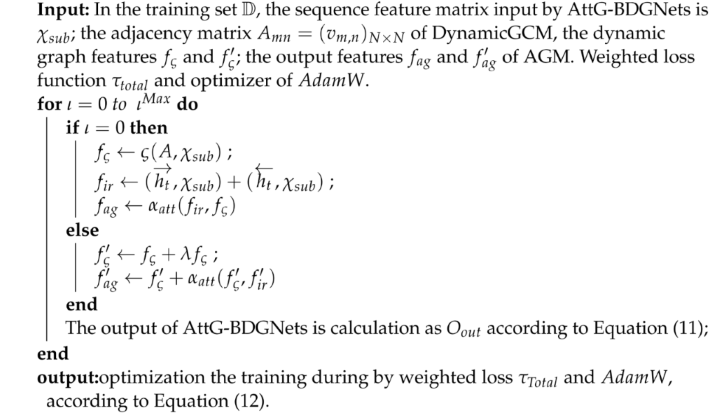 |
4. Experimental Results
4.1. Data Preparation
4.2. Evaluation Index
4.3. Parameter Settings
4.4. Ablation Study
4.5. Comparison with Other NILM Methods
4.6. Discussion
5. Conclusions and Future Research
Author Contributions
Funding
Informed Consent Statement
Acknowledgments
Conflicts of Interest
Abbreviations
| AttG-BDGNets | Attention-guided bidirectional dynamic graph IndRNN method |
| NILM | Non-intrusive load monitoring |
| IndRNN | Independently recurrent neural network |
| AGM | Attention guidance module |
| DynamicGCM | Dynamic graph convolution |
| Bi-IndRNN | Bidirectional independent recurrent neural network |
| GCN | Graph convolution network |
References
- Zeifman, M.; Roth, K. Nonintrusive appliance load monitoring: Review and outlook. IEEE Trans. Consum. Electron. 2011, 57, 76–84. [Google Scholar] [CrossRef]
- Kelati, A.; Gaber, H.; Plosila, J.; Tenhunen, H. Implementation of non-intrusive appliances load monitoring (NIALM) on k-nearest neighbors (k-NN) classifier. AIMS Electron. Electr. Eng. 2020, 4, 326–344. [Google Scholar] [CrossRef]
- Gong, F.; Han, N.; Zhou, Y.; Chen, S.; Li, D.; Tian, S. A svm optimized by particle swarm optimization approach to load disaggregation in non-intrusive load monitoring in smart homes. In Proceedings of the 2019 IEEE 3rd Conference on Energy Internet and Energy System Integration (EI2), Changsha, China, 8–10 November 2019; IEEE: Piscataway, NJ, USA, 2019; pp. 1793–1797. [Google Scholar]
- Rahimpour, A.; Qi, H.; Fugate, D.; Kuruganti, T. Non-intrusive energy disaggregation using non-negative matrix factorization with sum-to-k constraint. IEEE Trans. Power Syst. 2017, 32, 4430–4441. [Google Scholar] [CrossRef]
- Mueller, J.A.; Sankara, A.; Kimball, J.W.; McMillin, B. Hidden Markov models for nonintrusive appliance load monitoring. In Proceedings of the 2014 North American Power Symposium (NAPS), Pullman, WA, USA, 7–9 September 2014; IEEE: Piscataway, NJ, USA, 2014; pp. 1–6. [Google Scholar]
- Jia, Z.; Yang, L.; Zhang, Z.; Liu, H.; Kong, F. Sequence to point learning based on bidirectional dilated residual network for non-intrusive load monitoring. Int. J. Electr. Power Energy Syst. 2021, 129, 106837. [Google Scholar] [CrossRef]
- Hwang, H.; Kang, S. Nonintrusive load monitoring using an LSTM with feedback structure. IEEE Trans. Instrum. Meas. 2022, 71, 1–11. [Google Scholar] [CrossRef]
- Rafiq, H.; Shi, X.; Zhang, H.; Li, H.; Ochani, M.K. A deep recurrent neural network for non-intrusive load monitoring based on multi-feature input space and post-processing. Energies 2020, 13, 2195. [Google Scholar] [CrossRef]
- Liu, H.; Yu, C.; Wu, H.; Chen, C.; Wang, Z. An improved non-intrusive load disaggregation algorithm and its application. Sustain. Cities Soc. 2020, 53, 101918. [Google Scholar] [CrossRef]
- Lin, J.; Ding, X.; Qu, D.; Li, H. Non-intrusive load monitoring and decomposition method based on decision tree. J. Math. Ind. 2020, 10, 1–14. [Google Scholar] [CrossRef]
- Li, Z.; Feng, W.; Wang, Z.; Chen, H. Non-intrusive Load Identification Method based on SAGOAGMM Algorithm. Electroteh. Electron. Autom. 2021, 69, 59–65. [Google Scholar] [CrossRef]
- Lin, Y.H.; Tsai, M.S. Non-intrusive load monitoring based on swarm intelligence. In Proceedings of the 2019 8th International Congress on Advanced Applied Informatics (IIAI-AAI), Toyama, Japan, 7–11 July 2019; IEEE: Piscataway, NJ, USA, 2019; pp. 546–551. [Google Scholar]
- Xiao, Y.; Hu, Y.; He, H.; Zhou, D.; Zhao, Y.; Hu, W. Non-intrusive load identification method based on improved KM algorithm. IEEE Access 2019, 7, 151368–151377. [Google Scholar] [CrossRef]
- Mao, Y.; Dong, K.; Zhao, J. Non-intrusive load decomposition technology based on CRF model. In Proceedings of the 2021 IEEE Sustainable Power and Energy Conference (iSPEC), Nanjing, China, 23–25 December 2021; IEEE: Piscataway, NJ, USA, 2021; pp. 3909–3915. [Google Scholar]
- Zhao, M.; Liu, Q.; Jha, A.; Deng, R.; Yao, T.; Mahadevan-Jansen, A.; Tyska, M.J.; Millis, B.A.; Huo, Y. VoxelEmbed: 3D instance segmentation and tracking with voxel embedding based deep learning. In Proceedings of the Machine Learning in Medical Imaging: 12th International Workshop, MLMI 2021, Strasbourg, France, 27 September 2021; Proceedings 2. Springer International Publishing: Cham, Switzerland, 2021; pp. 437–446. [Google Scholar]
- Yao, T.; Qu, C.; Liu, Q.; Deng, R.; Tian, Y.; Xu, J.; Jha, A.; Bao, S.; Zhao, M.; Fogo, A.B.; et al. Compound figure separation of biomedical images with side loss. In Proceedings of the Deep Generative Models, and Data Augmentation, Labelling, and Imperfections: First Workshop, DGM4MICCAI 2021, and First Workshop, DALI 2021, Strasbourg, France, 1 October 2021; Proceedings 1. Springer International Publishing: Cham, Switzerland, 2021; pp. 173–183. [Google Scholar]
- Yao, T.; Qu, C.; Liu, Q.; Deng, R.; Tian, Y.; Xu, J.; Jha, A.; Bao, S.; Zhao, M.; Fogo, A. Deep Generative Models, and Data Augmentation, Labelling, and Imperfections. In Deep Generative Models, and Data Augmentation, Labelling, and Imperfections; Springer: Cham, Switzerland, 2021. [Google Scholar]
- Zheng, Q.; Yang, M.; Yang, J.; Zhang, Q.; Zhang, X. Improvement of generalization ability of deep CNN via implicit regularization in two-stage training process. IEEE Access 2018, 6, 15844–15869. [Google Scholar] [CrossRef]
- Kelly, J.; Knottenbelt, W. The UK-DALE dataset, domestic appliance-level electricity demand and whole-house demand from five UK homes. Sci. Data 2015, 2, 1–14. [Google Scholar] [CrossRef] [PubMed]
- Zhang, C.; Zhong, M.; Wang, Z.; Goddard, N.; Sutton, C. Sequence-to-point learning with neural networks for non-intrusive load monitoring. In Proceedings of the AAAI Conference on Artificial Intelligence, New Orleans, LA, USA, 2–7 February 2018; Volume 32. [Google Scholar]
- Shin, C.; Joo, S.; Yim, J.; Lee, H.; Moon, T.; Rhee, W. Subtask gated networks for non-intrusive load monitoring. In Proceedings of the AAAI Conference on Artificial Intelligence, Honolulu, HI, USA, 27 January–1 February 2019; Volume 33, pp. 1150–1157. [Google Scholar]
- Wei, J.; Li, C.; Yang, R.; Li, F.; Wang, H. Working Status Mining Enhanced Sequence-to-sequence Network for Non-intrusive Load Monitoring on Industrial Power Data. In Proceedings of the 2022 Power System and Green Energy Conference (PSGEC), Shanghai, China, 25–27 August 2022; IEEE: Piscataway, NJ, USA, 2022; pp. 874–881. [Google Scholar]
- Jaramillo, A.F.M.; Laverty, D.M.; Morrow, D.J.; del Rincon, J.M.; Foley, A.M. Load modelling and non-intrusive load monitoring to integrate distributed energy resources in low and medium voltage networks. Renew. Energy 2021, 179, 445–466. [Google Scholar] [CrossRef]
- Kong, W.; Dong, Z.Y.; Wang, B.; Zhao, J.; Huang, J. A practical solution for non-intrusive type II load monitoring based on deep learning and post-processing. IEEE Trans. Smart Grid 2019, 11, 148–160. [Google Scholar] [CrossRef]
- Moradzadeh, A.; Zakeri, S.; Oraibi, W.A.; Mohammadi-Ivatloo, B.; Abdul-Malek, Z.; Ghorbani, R. Non-Intrusive Load Monitoring of Residential Loads via Laplacian Eigenmaps and Hybrid Deep Learning Procedures. Sustainability 2022, 14, 14898. [Google Scholar] [CrossRef]
- Nie, Z.; Yang, Y.; Xu, Q. An ensemble-policy non-intrusive load monitoring technique based entirely on deep feature-guided attention mechanism. Energy Build. 2022, 273, 112356. [Google Scholar] [CrossRef]
- Faustine, A.; Pereira, L. Improved appliance classification in non-intrusive load monitoring using weighted recurrence graph and convolutional neural networks. Energies 2020, 13, 3374. [Google Scholar] [CrossRef]
- Jiao, X.; Chen, G.; Liu, J. A Non-Intrusive Load Monitoring Model Based on Graph Neural Networks. In Proceedings of the 2023 IEEE 2nd International Conference on Electrical Engineering, Big Data and Algorithms (EEBDA), Changchun, China, 24–26 February 2023; IEEE: Piscataway, NJ, USA, 2023; pp. 245–250. [Google Scholar]
- Jie, Y.; Yajuan, Q.; Lihui, W.; Yu, L. Non-Intrusive Load Decomposition Based on Graph Convolutional Network. In Proceedings of the 2022 IEEE 5th International Electrical and Energy Conference (CIEEC), Nanjing, China, 27–29 May 2022; IEEE: Piscataway, NJ, USA, 2022; pp. 1941–1944. [Google Scholar]
- Kipf, T.N.; Welling, M. Semi-supervised classification with graph convolutional networks. arXiv 2016, arXiv:1609.02907. [Google Scholar]
- Wu, B.; Wang, L.; Lv, S.X.; Zeng, Y.R. Forecasting oil consumption with attention-based IndRNN optimized by adaptive differential evolution. Appl. Intell. 2023, 53, 5473–5496. [Google Scholar] [CrossRef] [PubMed]
- Zhao, S.; Tang, H.; Liu, S.; Zhang, Y.; Wang, H.; Xu, T.; Chen, E.; Guan, C. ME-PLAN: A deep prototypical learning with local attention network for dynamic micro-expression recognition. Neural Netw. 2022, 153, 427–443. [Google Scholar] [CrossRef] [PubMed]
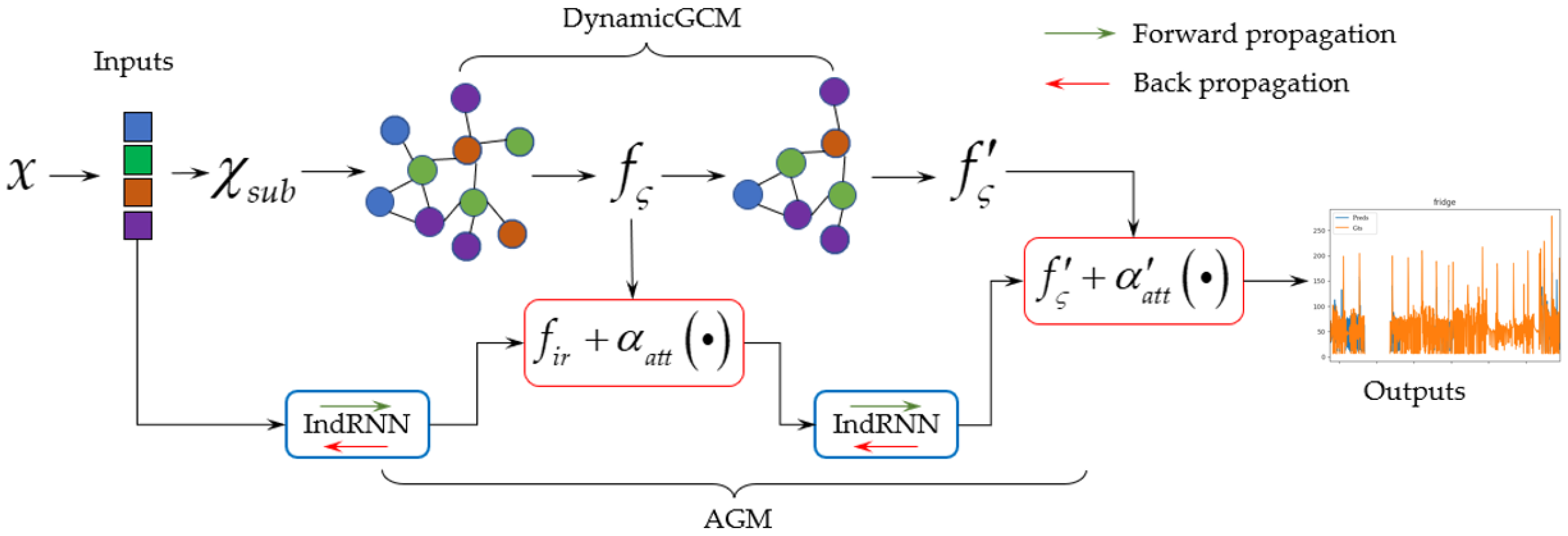
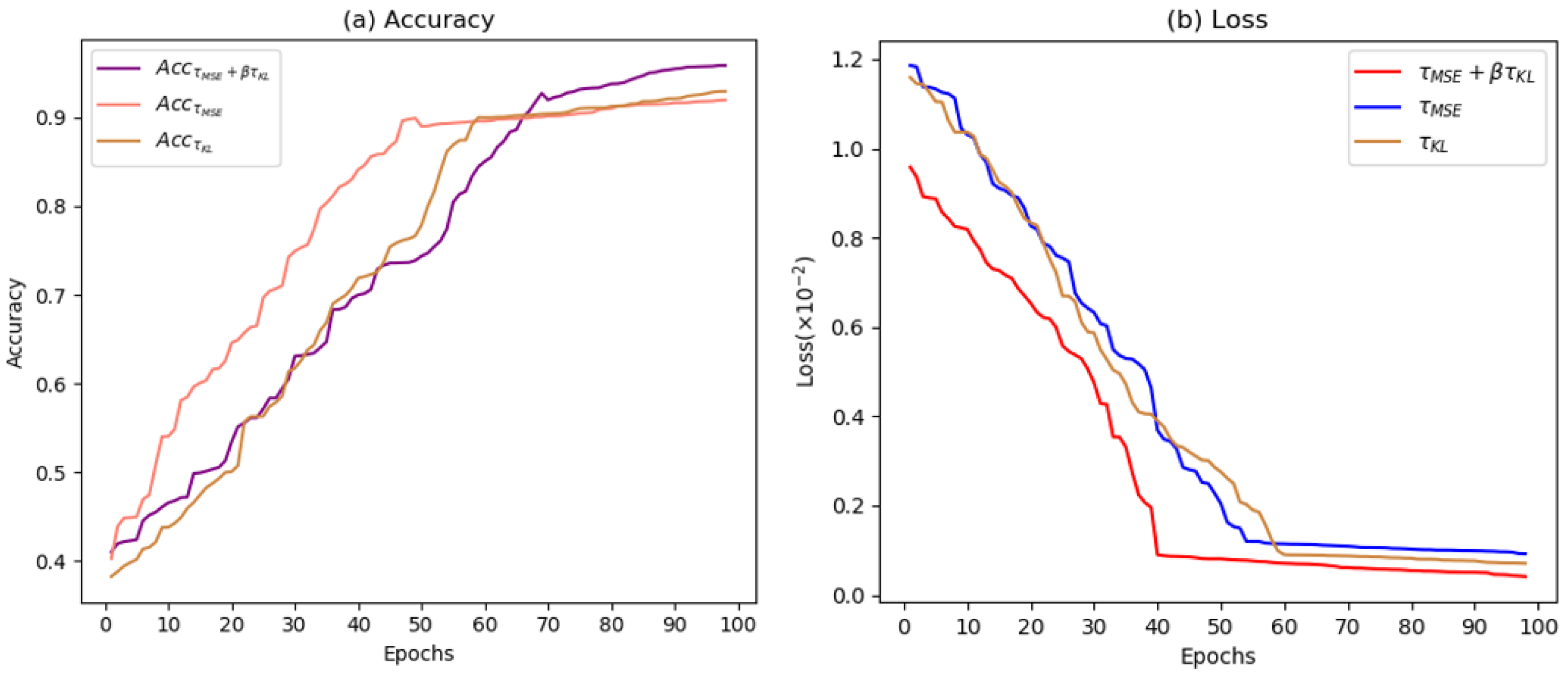
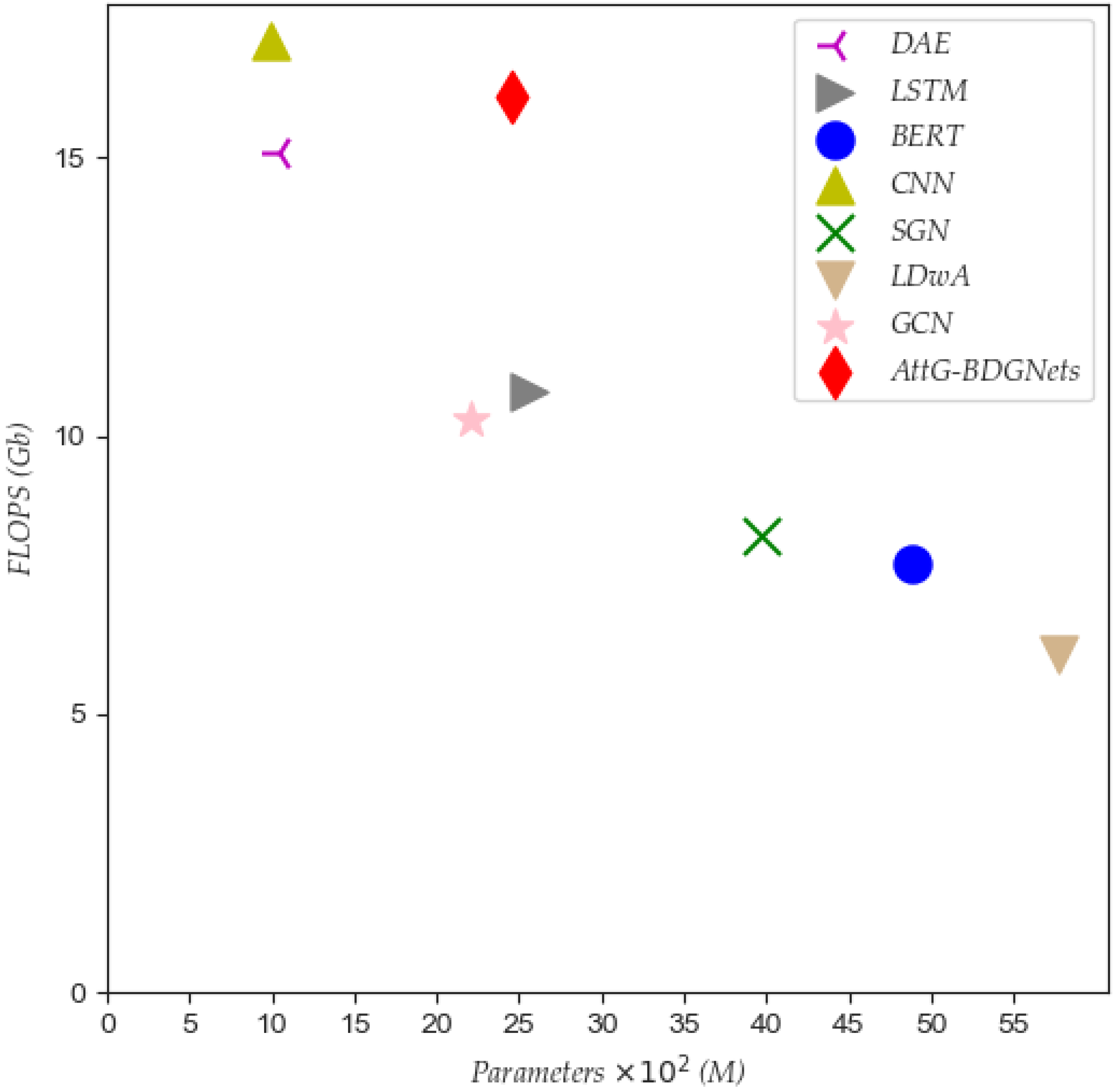
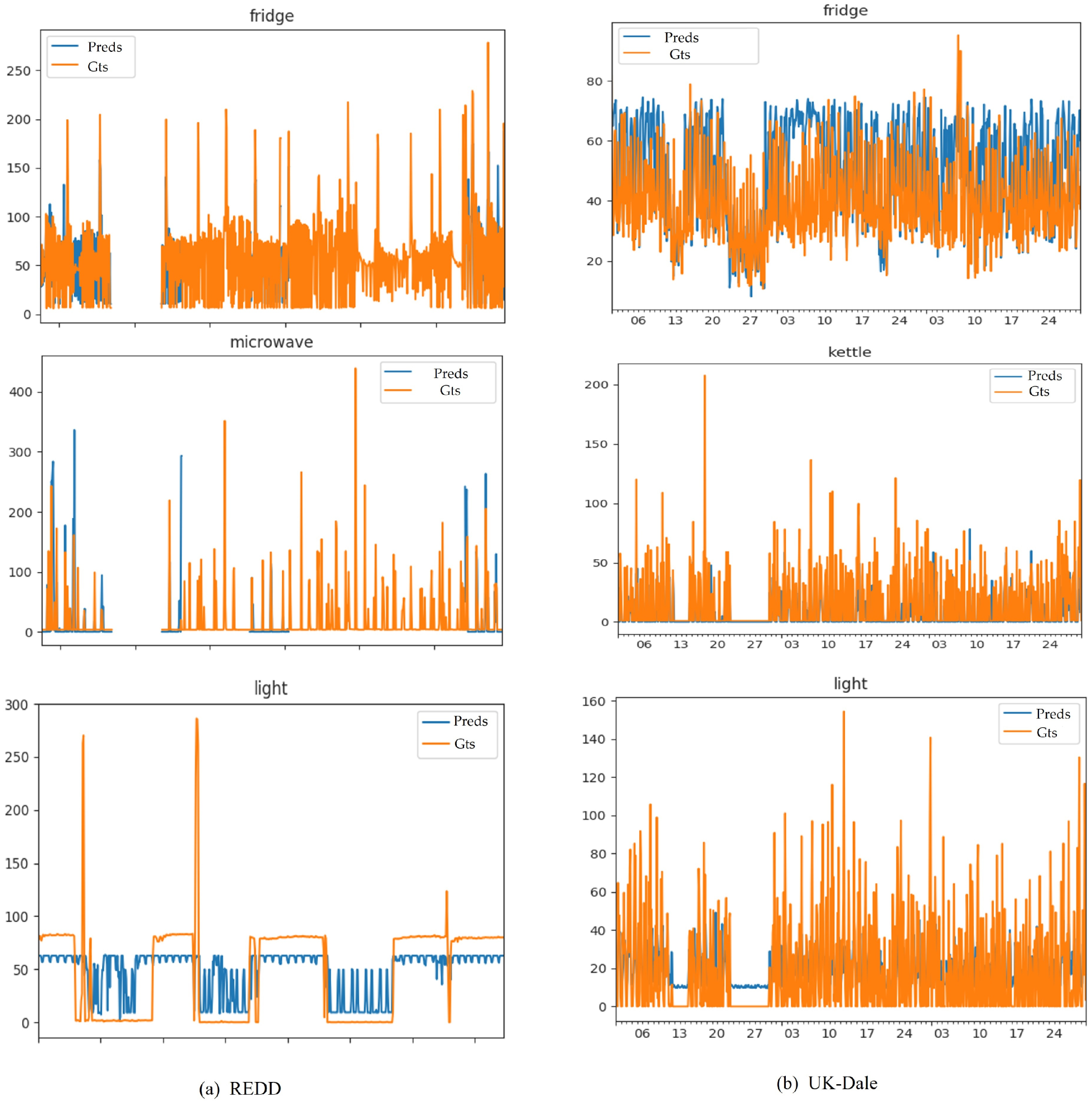
| Model Dataset | REDD | UK-Dale | |||
|---|---|---|---|---|---|
| DynamicGCM | Fridge | 23.09 | 0.798 | 22.56 | 0.794 |
| Washer | 25.62 | 0.727 | 8.72 | 0.508 | |
| Microwave | 16.02 | 0.561 | 7.09 | 0.593 | |
| Dishwasher | 15.67 | 0.608 | 12.54 | 0.665 | |
| Kettle | – | – | 8.14 | 0.943 | |
| Overall average | 20.2 | 0.677 | 11.81 | 0.701 | |
| Bi-IndRNN | Fridge | 23.87 | 0.781 | 23.59 | 0.779 |
| Washer | 26.02 | 0.715 | 9.33 | 0.486 | |
| Microwave | 16.88 | 0.547 | 8.12 | 0.584 | |
| Dishwasher | 17.03 | 0.584 | 13.78 | 0.651 | |
| Kettle | – | – | 10.08 | 0.925 | |
| Overall average | 20.95 | 0.657 | 12.98 | 0.685 | |
| AGL+RNN | Fridge | 22.52 | 0.804 | 21.55 | 0.801 |
| Washer | 24.16 | 0.734 | 8.31 | 0.511 | |
| Microwave | 15.39 | 0.571 | 6.83 | 0.599 | |
| Dishwasher | 15.22 | 0.619 | 12.04 | 0.67 | |
| Kettle | – | – | 7.44 | 0.947 | |
| Overall average | 19.32 | 0.682 | 11.23 | 0.706 | |
| Fridge | 21.73 | 0.804 | 21.36 | 0.804 | |
| Washer | 23.91 | 0.738 | 7.54 | 0.517 | |
| Microwave | 14.72 | 0.574 | 5.44 | 0.603 | |
| Dishwasher | 14.58 | 0.622 | 11.76 | 0.674 | |
| Kettle | – | – | 6.81 | 0.95 | |
| Overall average | 18.73 | 0.684 | 10.52 | 0.709 | |
| Fridge | 21.39 | 0.801 | 22.6 | 0.805 | |
| Washer | 23.48 | 0.744 | 7.59 | 0.514 | |
| Microwave | 14.88 | 0.571 | 5.49 | 0.603 | |
| Dishwasher | 14.37 | 0.624 | 11.46 | 0.677 | |
| Kettle | – | – | 6.14 | 0.961 | |
| Overall average | 18.53 | 0.685 | 10.65 | 0.712 | |
| AttG-BDGNets | Fridge | 21.18 | 0.812 | 20.36 | 0.808 |
| Washer | 23.54 | 0.748 | 7.32 | 0.522 | |
| Microwave | 14.39 | 0.579 | 5.18 | 0.606 | |
| Dishwasher | 14.32 | 0.624 | 11.38 | 0.678 | |
| Kettle | – | – | 6.25 | 0.952 | |
| Overall average | 18.35 | 0.691 | 10.09 | 0.713 | |
| Model Dataset | REDD | UK-Dale | |||
|---|---|---|---|---|---|
| DAE | Fridge | 30.14 | 0.735 | 27.94 | 0.658 |
| Washer | 28.59 | 0.423 | 15.07 | 0.318 | |
| Microwave | 25.02 | 0.261 | 14.67 | 0.349 | |
| Dishwasher | 28.88 | 0.469 | 23.19 | 0.525 | |
| Kettle | – | – | 12.33 | 0.896 | |
| Overall average | 28.16 | 0.482 | 18.64 | 0.549 | |
| LSTM | Fridge | 44.28 | 0.699 | 43.97 | 0.221 |
| Washer | 36.28 | 0.215 | 18.04 | 0.350 | |
| Microwave | 19.35 | 0.577 | 9.02 | 0.384 | |
| Dishwasher | 27.33 | 0.424 | 39.98 | 0.601 | |
| Kettle | – | – | 20.14 | 0.827 | |
| Overall average | 31.81 | 0.479 | 26.23 | 0.477 | |
| BERT | Fridge | 32.42 | 0.736 | 27.59 | 0.761 |
| Washer | 35.72 | 0.538 | 8.98 | 0.467 | |
| Microwave | 18.89 | 0.502 | 7.83 | 0.289 | |
| Dishwasher | 22.61 | 0.516 | 17.45 | 0.632 | |
| Kettle | – | – | 7.88 | 0.902 | |
| Overall average | 27.41 | 0.573 | 13.94 | 0.61 | |
| CNN | Fridge | 38.19 | 0.634 | 30.27 | 0.637 |
| Washer | 38.37 | 0.257 | 14.38 | 0.259 | |
| Microwave | 20.16 | 0.429 | 8.95 | 0.357 | |
| Dishwasher | 26.18 | 0.509 | 28.04 | 0.537 | |
| Kettle | – | – | 11.21 | 0.789 | |
| Overall average | 30.72 | 0.457 | 18.57 | 0.516 | |
| SGN | Fridge | 27.73 | 0.615 | 17.72 | 0.799 |
| Washer | 30.48 | 0.654 | 12.97 | 0.593 | |
| Microwave | 18.81 | 0.437 | 8.26 | 0.519 | |
| Dishwasher | 17.74 | 0.538 | 12.11 | 0.526 | |
| Kettle | – | – | 10.1 | 0.923 | |
| Overall average | 23.69 | 0.561 | 12.23 | 0.672 | |
| LDwA | Fridge | 23.88 | 0.776 | 15.42 | 0.821 |
| Washer | 25.97 | 0.72 | 9.65 | 0.664 | |
| Microwave | 13.14 | 0.658 | 5.69 | 0.575 | |
| Dishwasher | 10.56 | 0.714 | 9.77 | 0.627 | |
| Kettle | – | – | 7.68 | 0.981 | |
| Overall average | 18.38 | 0.717 | 9.64 | 0.733 | |
| GCN | Fridge | 17.66 | 0.858 | 30.17 | 0.194 |
| Washer | 30.09 | 0.668 | 12.35 | 0.485 | |
| Microwave | 20.65 | 0.421 | 8.77 | 0.268 | |
| Dishwasher | 10.38 | 0.584 | 41.96 | 0.562 | |
| Kettle | – | – | 18.33 | 0.908 | |
| Overall average | 19.69 | 0.632 | 22.31 | 0.483 | |
| AttG-BDGNets | Fridge | 21.18 | 0.812 | 20.36 | 0.808 |
| Washer | 23.54 | 0.748 | 7.32 | 0.522 | |
| Microwave | 14.39 | 0.579 | 5.18 | 0.606 | |
| Dishwasher | 14.32 | 0.624 | 11.38 | 0.678 | |
| Kettle | – | – | 6.25 | 0.952 | |
| Overall average | 18.35 | 0.691 | 10.09 | 0.713 | |
Disclaimer/Publisher’s Note: The statements, opinions and data contained in all publications are solely those of the individual author(s) and contributor(s) and not of MDPI and/or the editor(s). MDPI and/or the editor(s) disclaim responsibility for any injury to people or property resulting from any ideas, methods, instructions or products referred to in the content. |
© 2023 by the authors. Licensee MDPI, Basel, Switzerland. This article is an open access article distributed under the terms and conditions of the Creative Commons Attribution (CC BY) license (https://creativecommons.org/licenses/by/4.0/).
Share and Cite
Wang, Z.; Zhao, X. AttG-BDGNets: Attention-Guided Bidirectional Dynamic Graph IndRNN for Non-Intrusive Load Monitoring. Information 2023, 14, 383. https://doi.org/10.3390/info14070383
Wang Z, Zhao X. AttG-BDGNets: Attention-Guided Bidirectional Dynamic Graph IndRNN for Non-Intrusive Load Monitoring. Information. 2023; 14(7):383. https://doi.org/10.3390/info14070383
Chicago/Turabian StyleWang, Zuoxin, and Xiaohu Zhao. 2023. "AttG-BDGNets: Attention-Guided Bidirectional Dynamic Graph IndRNN for Non-Intrusive Load Monitoring" Information 14, no. 7: 383. https://doi.org/10.3390/info14070383
APA StyleWang, Z., & Zhao, X. (2023). AttG-BDGNets: Attention-Guided Bidirectional Dynamic Graph IndRNN for Non-Intrusive Load Monitoring. Information, 14(7), 383. https://doi.org/10.3390/info14070383







